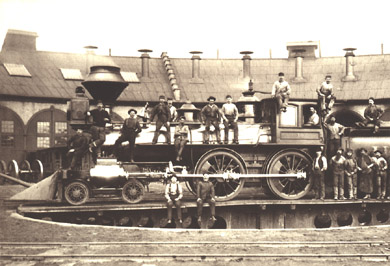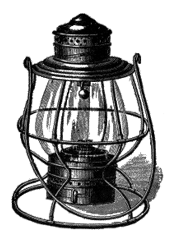Railroad Signals
 Signals have been used by railroads to move trains safely. Signals took many
forms, whistle signals
sent by the engineer, lantern signals sent by the train crew, and
later block signals were added alongside the mainline tracks.
Signals have been used by railroads to move trains safely. Signals took many
forms, whistle signals
sent by the engineer, lantern signals sent by the train crew, and
later block signals were added alongside the mainline tracks.
Grade crossing signals were also provided at road crossing to warn motor vehicle drivers of an approaching train.
Railway signalling is a system used to control railway traffic safely to prevent trains from colliding. Trains are uniquely susceptible to collision since they frequently operate at speeds that do not enable them to stop quickly or, in some cases, within the engineer's sighting distance.
Whistle Signals
Standard Whistle signals were developed as a means for the locomotive engineer to indicate to the train crew and others nearby what he was about to do.
Common Locomotive Whistle Signals, "O" indicates a short sound and "—" represents a long sound:
| O | Applying brakes, stopping |
| OO | Engineer's answer to any signal not otherwise provided for |
| OOO | When standing, about to back up |
| OOO | When running, stopping at next station |
| OOOO | Call for signals |
| Succession of short sounds | Alarm for persons or animals on the track |
| One long sound | Approaching stations, junctions and railroad crossings |
| — OO | A second section is following |
| — OOO | Flagman protect rear of train |
| — — | Releasing brakes. Proceeding |
| — — O — | Approaching a highway crossing at a grade |
| — — — — | Flagman may return from west or south |
| — — — — — | Flagman may return from east or north |
 Lantern or Hand Signals
Lantern or Hand Signals
When a train crew was picking up or dropping cars off at a siding, or waiting for another train to pass, standard lantern or hand signals would be used by the on the ground train crew to communicate to the engineer and other train crew members.
| A hand, flag or lantern: swung at a right angle to the track | Stop |
| Held horizontally at arm's length | Reduce speed |
| Raised and lowered vertically | Proceed |
| Swung horizontally above the head, when standing | Apply air brakes |
| Held at arms length above head, wen standing | Release air brakes |
| Any object waved violently by anyone on or near the track | Stop |
Block Signals
Block signals are used to indicate to a train crew that another train is in the block they are about to enter, or in the following block of track. Initially block signals were manually controlled by a human operator. Before clearing the signal, he was required to verify that any train that had previously entered the block was now clear of if, written records were kept, and a prescribed was procedure followed when communicating with another operator.
As the railroads main lines became busier, automatic block signals were introduced. The Southern Pacific completed installation of automatic block signals on their main lines in 1931.
 Some block signals were "semaphore" flags with a light. Often a semiphore would have an uper and lower flag close
together. Other block signals were just a light by itself.
Some block signals were "semaphore" flags with a light. Often a semiphore would have an uper and lower flag close
together. Other block signals were just a light by itself.
Sometimes there would be multiple signals on one pole to provide separate indications for the mainline and the siding. The lower signal would be for the diverging track.
There were a number of indications possible, for a single signal:
| Semaphore Position: | Light Color: | Indication: |
| Single: downward Double: both downward |
Green indication | ok to proceed |
| Single: right angle Double: both right angle |
Red indication | stop immediately |
| Double: top downward, lower right angle | Yellow indication | reduce to no faster than medium speed and to be prepared to stop before reaching the next signal |
| Flashing yellow | proceed prepared to pass next signal no faster than medium speed | |
| Flashing red | proceed no faster than restricted speed without stopping. |
Other combinations of multiple signals, and signs on the pole, such as the letter "G" communicated additional information to the locomotive engineer and train crew.
Grade Crossing Signals
Initially only a painted warning sign was posted at a railroad crossing, commonly this sign was in the form of an X with "railroad crossing" painted on it. As more motor vehicles began to use the roads it became necessary to provide a warning that a train was approaching. Lighted grade crossing signals in various forms emerged, "wig-wag" signals mechanically moved a single red light back and forth, later signals used two lights alternating flashing. In busy city areas mechanical gates would close.
This section is still in development, please check back soon.
Sharing A Heritage Railroad History Train Technology Railroad Operation Railroad Time Museums & Heritage Railroads Railroads Today
Pacific Time |
Entire web site copyright 2002-2015, DigitalNetExpress.com, Burbank, California. |
